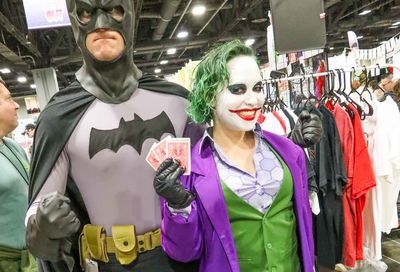Axis of Autos
Volkswagen and Land Rover are doing their best to keep up with demand as the brands' popularity revs wildly

Volkswagen must be feeling pretty reflective right now. This year sees the 65th anniversary of the humble Beetle’s introduction to the U.S. market, with the first Type 1 Beetle brought to these shores back in January 1949. It was imported by businessman Ben Pon Sr., the world’s first official Beetle importer. It found a market in the states, with sales of the Type 1 and another subsequent model slowly growing, leading to the establishment of the Volkswagen of America headquarters in New Jersey in 1955.
By the start of the swinging ’60s, there were more than 300,000 VW Bugs on American roads, meshing perfectly with the counter-culture of the decade. From custom paint jobs to open-top dune buggy models, Beetles were becoming an intrinsic part of American life. By 1968, Volkswagen was selling more than 420,000 per year. It lasted just nine years more, however, with the last Type 1 model leaving the assembly line in Germany in 1977. In its almost 30 years of sales, however, the original, air-cooled, rear-engined model worked its way into the hearts of many Americans. “[It] preserved its reputation of being more than just a car, but a symbol of uniqueness and freedom,” said president and CEO of Volkswagen America, Michael Horn. “The Beetle has become part of the cultural fabric in America and we are proud that its rich heritage continues to live with fans around the states.”
Fans of the Type 1 were treated to a modern reinvention when the New Beetle was introduced in 1998, featuring a fresh slant on the original’s iconic looks. This time around, however, the engine was water-cooled, front-mounted and the car’s underpinnings were ripped straight from the Volkswagen Golf. With its retro looks, a well-received convertible model and the iconic flower-pot on the dashboard, the New Beetle was a hit. Its popularity waned, especially with the launch of the BMW Mini, an arguably better update of a classic small car.
For just the second time since the original model’s German introduction in 1938, the Beetle was completely redesigned for the 2012 model year, dropping the “New” moniker. Out went the rounded, toy car appearance and in came a sleeker, longer, sportier design that aimed to attract male buyers to the Beetle, many of whom were turned off by the New Beetle’s slightly cutesy image, while remaining true to the profile of the original Type 1. The redesigned Beetle now sits as one of the most popular in Volkswagen’s current crop, selling 43,000 units in 2013.
Those figures add to Volkswagen’s increasing sales figures, with 2013 representing the second straight year the marque has managed sales over 400,000 in the U.S. — the first time this milestone has been achieved since the 1970s. That, in turn, aids another major achievement: Including sales of Volkswagen’s heavy-duty truck division, the German brand managed a claimed 9.73 million sales in 2013.
Impressive, yes, but that number is important for one reason. It puts Volkswagen ahead of General Motors for global sales, with the American marque mustering 9.71 million vehicle sales and slipping in the rankings, from second to third. Out in front with 9.98 million sales is Toyota, continuing to dominate, but even Toyota could soon fall should Volkswagen’s bold predictions ring true.
In 2011, Volkswagen foretold it would be the world’s No. 1 automaker by 2018, with global sales of more than 10 million per year. Back then, the brand was a distant third, trailing GM and Toyota by over 1 million vehicles sold per year — fast forward to today and the difference is reduced to just 250,000 vehicles, with 10 million sales in sight four years ahead of target. If VW can continue its current trajectory, it’s conceivable that it will meet a goal many balked at back in 2011 ahead of schedule.
LUXURY SUV MAKER Land Rover is also aware of the joy of rocketing sales. The British brand has experienced something of a renaissance in the past few years, with its Range Rover driving visibility around the globe. The Range Rover Evoque debuted a 21st century design direction, with its handsome, bold features diluted into the full-fat Range Rover and its lithe sibling, the Range Rover Sport.
Indeed, all three Range Rover models have been critical and commercial hits, so much so that Land Rover is maxing out its U.K.-based production plant to meet demand. Workers are crafting the incredible off-roaders 24 hours a day, five days a week, with buyers interested in the Range Rover, and the smaller Sport facing a wait of up to four months before their cars reach their driveways. The brand’s VP, Kim McCullough, told Edmunds, “Depending on where you are in the country, I would say the average is about a four-month wait right now for those products.”
Sales exploded in 2013, jumping by 56 percent to 12,221 SUVs, with overall Land Rover sales reaching more than 50,000 units. The secret to Land Rover’s current success, according to McCullough, is buyer retention. “It is amazing how many people have owned five, six, seven Range Rovers. That is a vehicle they consistently have in their household fleet. We have a lot of loyalty.”
That loyalty is apparently part of what is driving such strong demand, but wait times are expected to be reduced in the coming months as production issues are solved and processes streamlined. If you’re on your sixth or seventh Range Rover, however, we’re sure a few extra months wait in your current, leather-lined land yacht is hardly a punishment.
Support Metro Weekly’s Journalism
These are challenging times for news organizations. And yet it’s crucial we stay active and provide vital resources and information to both our local readers and the world. So won’t you please take a moment and consider supporting Metro Weekly with a membership? For as little as $5 a month, you can help ensure Metro Weekly magazine and MetroWeekly.com remain free, viable resources as we provide the best, most diverse, culturally-resonant LGBTQ coverage in both the D.C. region and around the world. Memberships come with exclusive perks and discounts, your own personal digital delivery of each week’s magazine (and an archive), access to our Member's Lounge when it launches this fall, and exclusive members-only items like Metro Weekly Membership Mugs and Tote Bags! Check out all our membership levels here and please join us today!





















